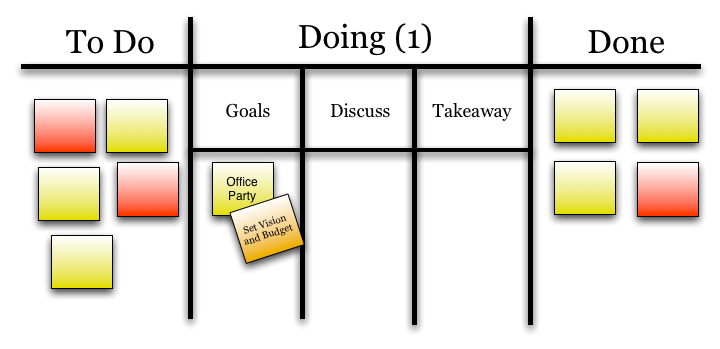The Personal Kanban blog ran a great pair of articles on “Lean Meetings” (part 1, part 2.)
I recommend reading through them to get more context for what follows, but I’ll re-share one of the biggest insights: the point of a meeting is to have a conversation. Pre-set agendas feel like best practice, but they can get in the way of that ’true goal’ more often than not.
Control, agendas, and procedures impeded conversation, focusing on the structure of the meeting rather than the topics at hand. If you want people to engage in and feel they’ve derived value from your meeting, make them feel respected, not restricted.
After having orchestrated a few meetings using this idea, some helpful practices have emerged, which seemed worth sharing.
The basic framework still holds:
- Framework: Draw a Personal Kanban
- Personal Agendas: Invite all attendees to write their topics on sticky notes
- Democratization: Invite all attendees to vote on the topics on the table (each person gets two votes)
- Group Agenda: Prioritize the sticky notes
- Discuss
The riffs on that list are:
Framework
We found that converting (To Do, Doing, Done) to (To Do, Goals, Doing, Takeaways, Done) has been helpful.
 Here is what those new substeps entail:
Here is what those new substeps entail:
Goals
Before we actually start discussing a topic, create a shared understanding of what we hope to get out of it. Paraphrasing David Allen, “what does ‘wild success’ look like at the end of this?” What is the value we need to deliver to our customers or organization by the time we’re done?
Concretely, this can come down to basic things. Plan fall employee event? The goals might be “Define vision, date, coordinator, and budget.”
It can also be fuzzier: “Understand each other’s feelings about this topic.”
In practice, it’s been interesting how hard it can be for a team to get this articulated – and there’s a high correlation between “hard to find goals” and “conversations that would wander and go nowhere.”
Mechanically, as is hinted at in the diagram above, we found it natural to add a new sticky with the goals on it as a “rider” to the original topic note. That kept the goals clear and visible to everyone, and they were referred to frequently.
Takeaways
This is probably implicit in what it means to move a topic from “Doing” into “Done”, but it’s helpful as a reminder. “Who is responsible for taking things away from this item?” It’s a good hook for recording things, especially if there’s no formal note-taker.
We also use this as a hook to make sure to consider how any conclusions (or lack thereof) need to be communicated to the wider group that was not in attendance at the meeting.
Personal Agendas
At this point we’ve only really used this idea as-written, but I’m curious to play with various brainstorming/gamestorming or focusing techniques to help generate higher-value items for the team to choose from, rather than those that happen to be top-of-mind for the participants (or have been recorded in their own trusted systems.)
We did bring an idea from Kanban in – ‘item types.’ This was helpful at an all-day monthly meeting one of our teams have. We created a special designation (color of sticky works, as pictured above, or a separate section in the backlog) for items that are “Today Or They Die” – things which will happen between now and the next meeting, regardless of if we discuss them or not. If it’s December 1, and your next Meeting is Jan 1, you should probably make your Christmas plans.
This can help with voting; those items may still not end up getting selected for discussion, but at least the team has a shared understanding that we’re letting the opportunity pass.
It’s mentioned in the linked articles, but the feature of being able to discover new items “on the fly” and work them seamlessly into the backlog is amazingly useful. In life things are fundamentally interconnected so it’s to be expected and encouraged that we’ll discover or create things that need discussion as a function of discussion. Agendas hate this idea.
Democratization
The ’everyone gets N votes’ method works well. We also experimented with a few other methods of prioritization:
- “If you only get to discuss one thing today…”: each member gets to select one item to bring into To Do. Perhaps more Socialist than Democratic, but it was a nice way to start off the day.
- “Lightning Round”: Are there any topics remaining in the backlog we can get through productively in 5 minutes or less? This was a fun way to get back into things after a lunch break, but somewhat risky – one of the items selected turned into a 45 minute discussion.
One challenge with voting early in the discussion, particularly for all-day meetings, is allowing priority to evolve over time as perspectives and time pressures change. Using voting just to bring a few items into the ready queue, and then voting again (from scratch) to repopulate when it empties, seemed to work well.
Conclusion
This way of organizing meetings has really enhanced the quality of our discussions and the value they deliver. It ends up feeling much more natural – still providing the compass and context we’re frustrated about not having in a truly chaotic meeting, without the rigidity and creator bias that an agenda brings. After two separate meetings, participants made comments like “that was the most productive and engaging meeting I’ve ever been a part of.” That’s reason enough to continue exploring!
Thanks again to Jim and Tonianne for the education and inspiration.
